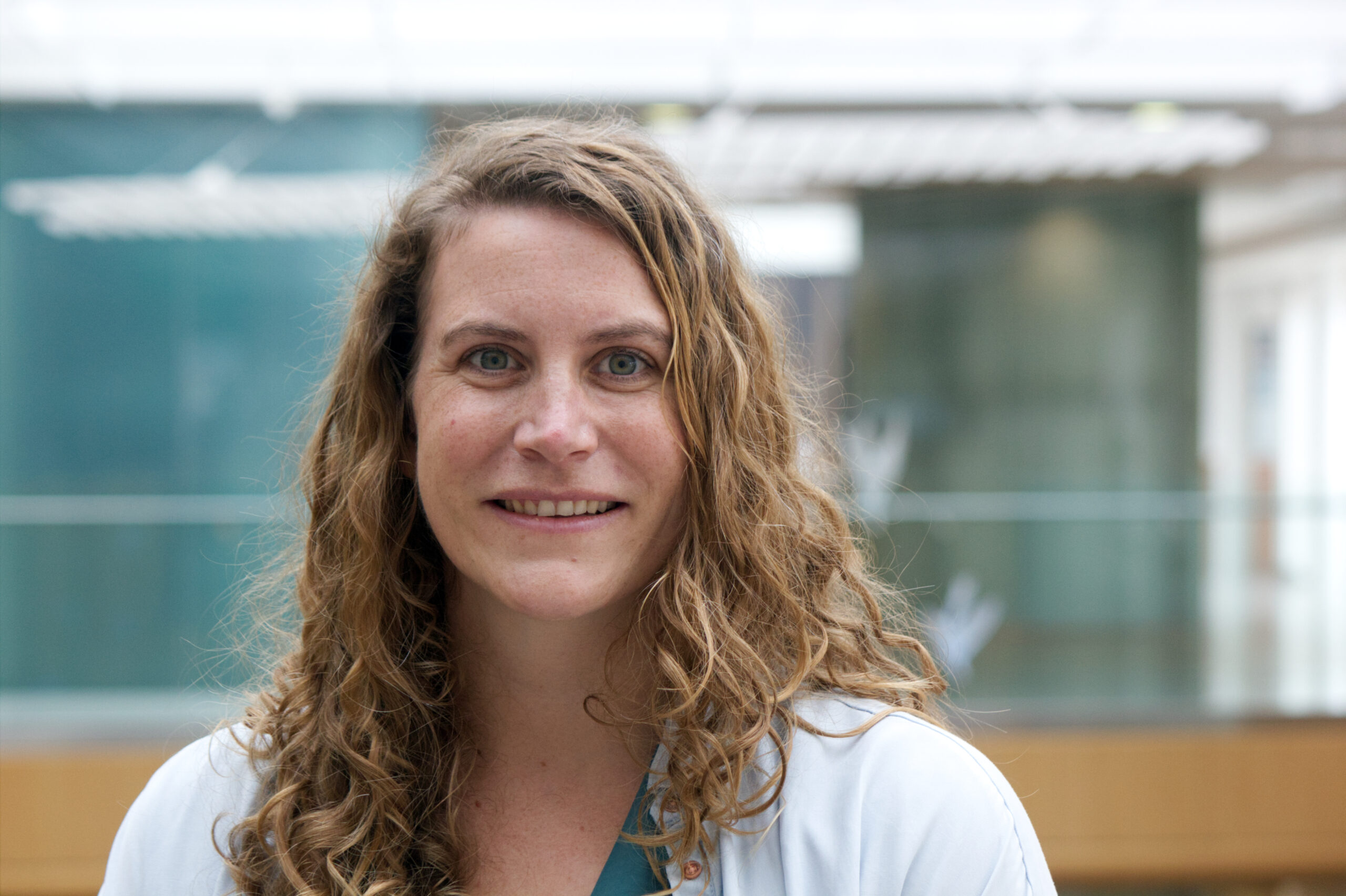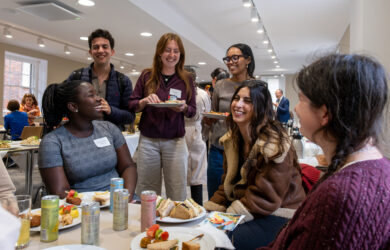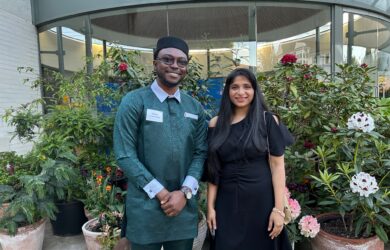
Rebecca Berrens is setting up her own lab to research the role of transposable elements in genetic diseases.
Half of the human genome is made up of transposable elements. This is an understudied area. They are mostly silenced, but are highly expressed in early development and we don’t know why.
Rebecca Berrens
What causes genetic disease? Rebecca Berrens’ research focuses on transposable elements or transposons, pieces of DNA formed as a result of ancient viruses that inserted into our genome. These can damage genes when they are active in the early stages of human development because they are able to move about the genome. This can result in genetic illnesses and can play a part in some cancers.
Rebecca [2012] says: “Half of the human genome is made up of transposable elements. This is an understudied area. They are mostly silenced, but are highly expressed in early development and we don’t know why. Sometimes they insert themselves into genes and disrupt their function, causing disease, and they may play a role in regulating gene expression. However, it has been found that they need to be expressed for early mammalian development. We need to understand how much they control our genome and what the relationship is. They make sense in an evolutionary context as sometimes they give rise to really important genes, but they also damage genes.”
Rebecca recently won eight years of funding through a Wellcome Trust Career Development grant which she is using to set up the Berrens laboratory in the Institute of Developmental and Regenerative Medicine at the University of Oxford. This will enable her to continue her research using an innovative new method she developed for studying how transposable elements function.
Background
Rebecca, whose father is a biology and chemistry teacher, developed an early fascination with molecular biology, having been introduced to biochemistry by a teacher at her school in Germany. “I loved molecules and trying to understand the structure of DNA,” she says. “It really stuck with me.”
After school she opted to study Medicine because she thought she needed to do so in order to be able to do research. Before she started her undergraduate degree she did an internship in a hospital. That experience taught her that being a doctor was not for her. She was very happy that she made this discovery and instead signed up for Molecular Cell Biology at University of Heidelberg. At university through her undergraduate and then master’s courses she did several internships and developed her passion for research. Working in different laboratories gave her a broad exposure to different areas of science, from neuroscience to biophysics, but molecular biology was what most interested her. At undergraduate level she studied miRNAs and was fascinated by the function of these small RNAs in the cell. At master’s level she focused on molecular biotechnology and learned for the first time about transposable elements.
During that time she won an Amgen scholarship to Cambridge and was encouraged to talk to people at Cambridge about continuing her research there. At the time, Rebecca was keen to further her studies in the US and went there to complete her master’s thesis. However, she kept in touch with people in Cambridge and when a PhD position in epigenetics became available she applied. She needed the Gates Cambridge funding to be able to do it, however, so she found herself in a lab in the US at 4.30am waiting to do the interview for the scholarship. She was successful.
Cambridge
Rebecca started her PhD in 2013 and enjoyed the freedom to do her own work in the laboratory. Her focus was on epigenetic reprogramming in mammalian development.
She published a core paper on her research in 2017, shortly after completing her viva. It explored how molecules called endosiRNAs help mammals avoid the potential for genetic chaos early on in life.
The chaos is caused by transposons which can be controlled by chemical markers in DNA called methylations, but most methylations are temporarily erased and renewed by a process called epigenetic reprogramming. This means that, during sperm and egg production, there is a short time when methylations do not control transposon activity, leaving them free to damage genes and shuffle DNA. Rebecca’s research discovered how active transposons can be shut down by the endogenous small interfering RNAs (endosiRNAs) system. This happens when cells detect messages from active transposons and use them to create specific endosiRNA which act like a trap, allowing a protein called Dicer to seek and destroy transposon messages before they cause any harm.
At Cambridge Rebecca was a member of the Gates Cambridge Scholars Council and also started up a UK branch of Liter of Light, a global open source movement which aims to provide an ecologically and economically sustainable source of light to underprivileged households that do not have access to electricity or have difficulties affording electricity. It involves filling up a 1.5L PET bottle with purified water and bleach and installing in onto the roof of a house. The water inside the bottle refracts the sunlight during the daytime and creates the same intensity as a 55 watt light bulb.
CELLO-seq
When she graduated, Rebecca did a short post-doctoral fellowship. She found a lab in Cambridge doing single cell analysis, but realised that, to continue her work on understanding the roles of transposable elements in cellular differentiation, she needed to develop her own method for studying them. She started her postdoctoral studies with John Marioni. The Marioni lab is focused on method development. Rebecca was one of the only ones in the lab doing wetlab and therefore had to set up their own lab area. In 2019, she was awarded a four-year Sir Henry Wellcome Fellowship and started to develop her CELLO-seq computational framework for performing long-read RNA sequencing at single cell resolution.
During Covid Rebecca and her husband decided to move to Oxford. Rebecca was commuting between Cambridge and Oxford for a time. She was also pregnant and sent her paper on CELLO-seq off to her co-author on the day she gave birth. It was subsequently published in Nature Biotechnology.
She says being pregnant and having a newborn increased her interest in developmental biology in addition to molecular cell biology. “I cared about the cells that were making my baby. They all have a function,” she says.
After coming back from maternity leave, Rebecca secured an extension on her Sir Henry Wellcome fellowship because of Covid and also secured a Transition Fellowship with the Department of Paediatrics and the Institute of Developmental and Regenerative Medicine. This allowed her to set up her lab and recruit a research assistant to collect crucial preliminary data to apply to the Wellcome trust for funding to set up her own laboratory.
The Wellcome Trust Career Development grant will fund the advancement of research into locus-specific transposable elements in development for eight years. As principal investigator of the Transposon Group, Rebecca proposes to employ CELLO-seq and a wide range of functional tools to investigate the function of locus-specific transposable element expression in development and cell fate decision. The group will test specific hypotheses about the role of locus-specific TE expression in mouse pre-implantation and embryonic stem cells.
So far the Berrens lab has recruited two PhD students and a research assistant and is looking to add some post-doctoral students as well as more PhD students in September. The security of eight years of funding makes it an attractive proposition for many students.












